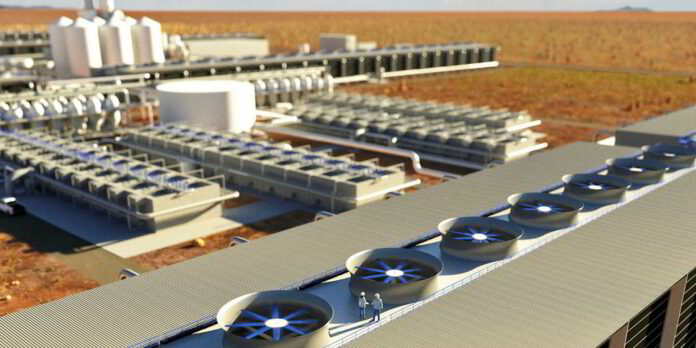Direct Air Capture, also known as DAC, is one of a number of carbon capture technologies seen as a way to mitigate the worst impacts of global warming. The technology harvests carbon dioxide (CO2) from ambient air. It is not an add-on to a coal-fired or natural-gas thermal power plant, but rather a standalone solution to removing CO2 from the atmosphere for the purpose of permanently sequestering it underground.
A leader in this form of carbon capture and sequestration (CCS) is Carbon Engineering, a Canadian-based company whose demonstration plant sits in Squamish, British Columbia. Bill Gates is an investor. And now Occidental Petroleum through its subsidiary 1PointFive has entered into a partnership to build and deploy a minimum of 70 or as many as 135 DAC plants like the one seen in the picture above by 2035.
Each facility will have the capacity to remove a megaton of CO2 from the atmosphere annually. The methodology uses a tower structure containing an array of giant fans which pull in air that then passes over a solution containing potassium hydroxide which attracts and binds the CO2 to it. Once captured the CO2 can then be compressed and shipped by pipeline to a sequestering site. And although a megaton sounds like a lot of CO2, it really is not.
If DAC technology is our solution for removing CO2 from the atmosphere, we will need many more DAC plants than what this new partnership is promising to build. That’s because the forecasted number for the amount of CO2 we will need to remove annually by 2050 is expected to be 10 to 20 Gigatons. That means, if we were just to use DAC technology, we would need 10 to 20,000 plants in operation to neutralize our carbon emissions.
Carbon Engineering has been building partnerships across the globe. There are plans to build facilities in the United Kingdom, Norway, and more in Canada. But the current cost of DAC is not cheap with the company claiming it is capturing CO2 at a $127 US per ton cost. The Occidental partnership DAC plants, however, indicate a per ton cost of between $382 and $542 US. At $127 let alone the higher figures from Occidental, DAC, therefore, appears to be cost-prohibitive as a carbon removal global solution.
It begins to make sense when governments put a price on carbon. Without every ton of CO2 produced having a unit value there is little incentive to begin building a DAC infrastructure. That’s why it makes sense to adopt global carbon pollution pricing.
Currently, few nations have implemented carbon pricing. Canada is one in the form of a levy per ton produced at the source. The per ton price is currently $50 Canadian (which is about $39 US), which is well below the $127 Carbon Engineering says is the capture cost for CO2. Canada’s carbon price rises annually at the rate of $15 ($12 US). In 2030 or 2031 the price on carbon will be $155 and $170 respectively which will approximate the current $127 US cost per ton. To get to the extraction costs per ton Occidental is forecasting, carbon pricing needs to get much higher faster.
So something has to change for DAC to make sense. The technology needs to get cheaper which it likely will as more facilities are built which makes the Occidental price estimates per ton to be a bit weird. Of course, reductions in fossil fuel demand and use will greatly reduce the need, as will a move by industries and the transportation sector to low-carbon and net-zero technologies and processes.










[…] projects have been on the increase very recently. This year Occidental Petroleum in partnership with Carbon Engineering, a direct-air capture CO2 technology announced plans to […]
[…] the Canadian company, Carbon Engineering. Last year, I wrote about this company entering into a contract with Occidental Petroleum to deploy between 70 and 135 of the former’s CO2 Direct Air Capture (DAC) plants. Well, it […]
[…] emissions. You can plug Opus into a Direct Air Capture (DAC) plant like the ones developed by Carbon Engineering, the Canadian company working with Occidental Petroleum to reduce carbon emissions from the […]